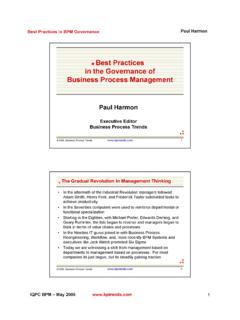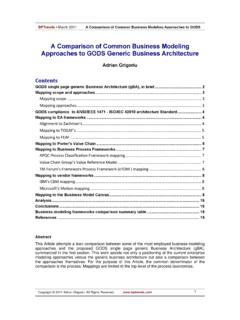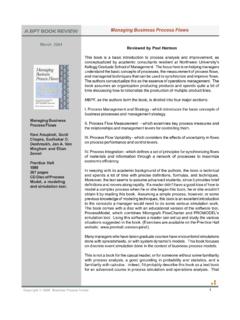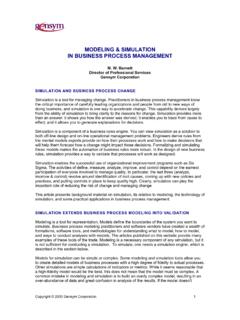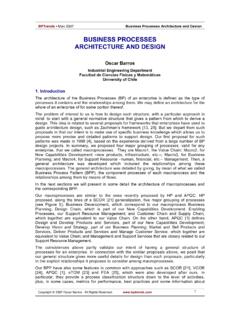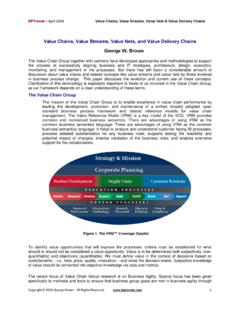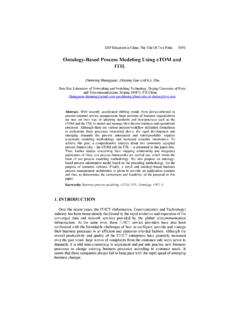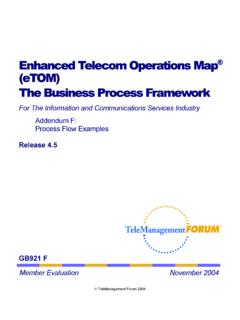Transcription of TECHNICAL BRIEF The TeleManagement Forum's NGOSS …
1 Celia WolfCEO and Senior AnalystBusiness process TrendsSeptember 2003 TECHNICAL BRIEF1 2003 business process Trends1234567890123456789012345678901212 3456789012345612345678901234567890123456 7890121234567890123456123456789012345678 9012345678901212345678901234561234567890 1234567890123456789012123456789012345612 3456789012345678901234567890121234567890 1234561234567890123456789012345678901212 3456789012345612345678901234567890123456 7890121234567890123456123456789012345678 9012345678901212345678901234567890123456 7890121234567890123456789012345678901212 3412345678901234567890123456789012123456 7890123456789012345678901212345678901234 5678901234567890121234123456789012345678 9012345678901212345678901234567890123456 7890121234567890123456789012345678901212 3412345678901234567890123456789012123456 7890123456789012345678901212345678901234 5678901234567890121234123456789012345678 9012345678901212345678901234567890123456 7890121234567890123456789012345678901212 3412345678901234567890123456789012123456 7890123456789012345678901212345678901234 5678901234567890121234123456789012345678 9012345678901212345678901234567890123456 7890121234567890123456789012345678901212 3412345678901234567890123456789012123456 7890123456789012345678901212345678901234 5678901234567890121234123456789012345678 9012345678901212345678901234567890123456 7890121234567890123456789012345678901212 34 The TeleManagement Forum's NGOSS FrameworkThe TeleManagement forum is an industry consortium of telecommunicationscompanies.
2 They held their last meeting in Nice, France, in May, and will be holdingtheir next meeting in Dallas, Texas on November 10-13, 2003. The forum provides aplace for those involved in the telecom industry to get together to share informationabout business and IT developments in telecommunications. It also provides anopportunity for those involved in the development of the TeleManagement forum sNGOSS effort to meet and coordinate their TeleManagement forum s New Generation Operations Systems and Software( NGOSS ) effort aims to develop an architectural framework for organizing, integratingand implementing telecom systems. The NGOSS effort is driven by an analysis oftelecom business processes (eTOM) which was initially begun in 1995 and hasaccelerated since 2000. The current overview of the effort is illustrated in Figure 1. An overview of the TeleManagement forum s NGOSS 1 illustrates four perspectives or sources of the growing NGOSS knowledgebase of standards, tools and best Starting at the bottom left, business process analysis has resulted in a businessprocess map of high-level telecom processes.
3 The resulting business process frameworkis called the enhanced Telecom Operations Map (eTOM). eTOM provides a graphicalBusinessProcess Map(eTOM)BusinessProcessAnalysisComplian ceTestsSolutionConformanceTestingSharedI nformation/Data Model(SID)SystemsAnalysis &DesignContractInterface &TechnologyNeutralArchitectureSolutionAn alysis &DesignNGOSSK nowledgeBaseKnowledge Base isUpdated as Componentsare Tested and WolfCEO and Senior AnalystBusiness process TrendsSeptember 2003 TECHNICAL BRIEF2 2003 business process Trends1234567890123456789012345678901212 3456789012345123456789012345678901234567 8901212345678901234512345678901234567890 1234567890121234567890123451234567890123 4567890123456789012123456789012345123456 7890123456789012345678901212345678901234 5123456789012345678901234567890121234567 8901234512345678901234567890123456789012 1234567890123451234567890123456789012345 6789012123456789012345678901234567890121 2345678901234567890123456789012123123456 7890123456789012345678901212345678901234 5678901234567890121234567890123456789012 3456789012123123456789012345678901234567 8901212345678901234567890123456789012123 4567890123456789012345678901212312345678 9012345678901234567890121234567890123456 7890123456789012123456789012345678901234 5678901212312345678901234567890123456789 0121234567890123456789012345678901212345 6789012345678901234567890121231234567890 1234567890123456789012123456789012345678 9012345678901212345678901234567890123456 7890121231234567890123456789012345678901 2123456789012345678901234567890121234567 8901234567890123456789012123123456789012 3456789012345678901212345678901234567890 1234567890121234567890123456789012345678 9012123123456789012345678901234567890121 2345678901234567890123456789012123456789 01234567890123456789012123 The TeleManagement Forum's NGOSS Frameworkoverview of the business processes used by all telecoms, and a common vocabularythat all telecoms can use.
4 In addition, process flowplans are provided for a growingnumber of key etom framework defines processes at three levels. At the top level there are fourmajor business processes: (1) a Fulfillment process , (2) an Assurance process , (3) aBilling process , and (4) an Operations Support and Readiness Core process . Eachof these is divided into sub-processes. Thus, the Fulfillment process includessubprocesses like SP Busing, S/P Purchase Order Management, S/P InterfaceManagement, Resource Provisioning and Allocation to Service Instance, ServiceConfiguration and Activation, and Customer Interface Management Interface. Thesesub-processes, themselves, are then divided into major business processes cut across functional silos, but the sub-processes tendto be assigned to specific functions, or to multiple functions. The eTOM model identifiesfour functional units: (1) Management Supplier/Partner Relationship, (2) ResourceManagement and Operations (IT), (3) Service Management and Operations, and (4)Market, Product, and Customer Relationship essence, a telecom sells time on its network to customers.
5 Since the time is soldand monitored by means of computers that track phone access, Service and Resourceare important functions. Since almost all long distance phone calls cross multiplenetworks, arrangements with other telecom companies partners are very suspect that actual phone companies might sub-divide their departments somewhatdifferently; placing marketing and service in separate departments, but remember thatmost phone sales and service requests come in through a common call center, so thishigh-level grouping works reasonably well. (See Figure 2.) (Note that in Figure 2 thewhite horizonal bars are departments or functional units, while the processes are shownas vertical columns.)SID. Continuing clockwise, we come to the Shared Information/Data Model (SID).SID provides a common language for software providers and integrators seeking todescribe management information and elements or entities to be stored in and an Architecture.
6 At the top right of the figure we are concerned withdefining how software components can be constructed to implement businessprocesses. An overall, platform-neutral architecture and an interface (API) model definethe principles that allow developers to create OSS components that can be used indistributed telecom Tests. Finally, a suite of tests assures that products conform to eTOM,SID and NGOSS architectural and interface specifications. The tests allow vendors toachieve certification for complying with one or multiple NGOSS addition to these four key elements that make up the NGOSS framework andknowledge base, there are supporting tools. A series of documented, demonstrationprojects to show how the framework can be applied, and a NGOSS developmentmethodology are being demonstration, or Catalyst projects are multi-vendor collaborative efforts that illustrateand test the use of the NGOSS framework in practical WolfCEO and Senior AnalystBusiness process TrendsSeptember 2003 TECHNICAL BRIEF3 2003 business process
7 Trends1234567890123456789012345678901212 3456789012345123456789012345678901234567 8901212345678901234512345678901234567890 1234567890121234567890123451234567890123 4567890123456789012123456789012345123456 7890123456789012345678901212345678901234 5123456789012345678901234567890121234567 8901234512345678901234567890123456789012 1234567890123451234567890123456789012345 6789012123456789012345678901234567890121 2345678901234567890123456789012123123456 7890123456789012345678901212345678901234 5678901234567890121234567890123456789012 3456789012123123456789012345678901234567 8901212345678901234567890123456789012123 4567890123456789012345678901212312345678 9012345678901234567890121234567890123456 7890123456789012123456789012345678901234 5678901212312345678901234567890123456789 0121234567890123456789012345678901212345 6789012345678901234567890121231234567890 1234567890123456789012123456789012345678 9012345678901212345678901234567890123456 7890121231234567890123456789012345678901 2123456789012345678901234567890121234567 8901234567890123456789012123123456789012 3456789012345678901212345678901234567890 1234567890121234567890123456789012345678 9012123123456789012345678901234567890121 2345678901234567890123456789012123456789 01234567890123456789012123 The TeleManagement Forum's NGOSS FrameworkThe NGOSS methodology currently being developed by a committee will combinethe strengths of the Zachman framework , RM-ODP, USDP and the OMG s ModelDriven Architecture (MDA).
8 In essence, the methodology describes an approach foranalyzing, designing and generating component-based applications that are verticallyaligned. Figure 3 suggests how the NGOSS methodology relates to Zachman Release with the latest versions of eTOM (ver. 3, GB921), SIM ( ), SID (ver. 2 GB922), the complete Technology Neutral Architecture (TMF053)and the Testing Suite (TMF050) was approved at the spring meeting of theTeleManagement forum in May of is a work in progress and teams continue to work on all aspects of theframework. This June, for example, eTOM , with further process decompositions,was released, and the methodology and Catalyst demonstration projects are anceBillingOperationsSupport &Readi nessCustomer Rel ati onship ManagementService Management & OperationsResource Management & OperationsSupplier/Partner Relationship Management(Appli cati on, Computi ng and Network)OperationsFulfillmentAssur anceBillingOperationsSupport &Readi nessCustomer Rel ati onship ManagementService Management & OperationsResource Management & OperationsSupplier/Partner Relationship Management(Appli cati on, Computi ng and Network)
9 Enterprise ManagementStrategic &EnterprisePl anningFinancial & AssetManagementEnterprise QualityManagement, process & ITPl anni ng & Archi t ectureStakeholder & ExternalRel at i ons ManagementBrand Management,Market Research &AdvertisingHuman ResourcesManagementDisaster Recovery,Securi ty & FraudManagementResearch &Development,TechnologyAcquisitionEnterp rise ManagementStrategic &EnterprisePl anningFinancial & AssetManagementEnterprise QualityManagement, process & ITPl anni ng & Archi t ectureStakeholder & ExternalRel at i ons ManagementBrand Management,Market Research &AdvertisingHuman ResourcesManagementDisaster Recovery,Securi ty & FraudManagementResearch &Development,TechnologyAcquisitionStrate gy, Infrastructure & ProductProductLifecycleManagementInfrast ructureLifecycleManagementStrategy &Commi tMarketing & Offer ManagementService Development & ManagementResource Development & ManagementSuppl y Chai n Devel opment & Management(Application, Computing and Network)Strategy, Infrastructure & ProductProductLifecycleManagementInfrast ructureLifecycleManagementStrategy &Commi tMarketing & Offer ManagementService Development & ManagementResource Development & ManagementSuppl y Chai n Devel opment & Management(Application, Computing and Network)CustomerCustomerFigure 2.
10 Overview of the TeleManagement forum s etom framework showing Level1 WolfCEO and Senior AnalystBusiness process TrendsSeptember 2003 TECHNICAL BRIEF4 2003 business process Trends1234567890123456789012345678901212 3456789012345123456789012345678901234567 8901212345678901234512345678901234567890 1234567890121234567890123451234567890123 4567890123456789012123456789012345123456 7890123456789012345678901212345678901234 5123456789012345678901234567890121234567 8901234512345678901234567890123456789012 1234567890123451234567890123456789012345 6789012123456789012345678901234567890121 2345678901234567890123456789012123123456 7890123456789012345678901212345678901234 5678901234567890121234567890123456789012 3456789012123123456789012345678901234567 8901212345678901234567890123456789012123 4567890123456789012345678901212312345678 9012345678901234567890121234567890123456 7890123456789012123456789012345678901234 5678901212312345678901234567890123456789 0121234567890123456789012345678901212345 6789012345678901234567890121231234567890 1234567890123456789012123456789012345678 9012345678901212345678901234567890123456 7890121231234567890123456789012345678901 2123456789012345678901234567890121234567 8901234567890123456789012123123456789012 3456789012345678901212345678901234567890 1234567890121234567890123456789012345678 9012123123456789012345678901234567890121 2345678901234567890123456789012123456789 01234567890123456789012123 The TeleManagement Forum's NGOSS FrameworkFigure 3.

